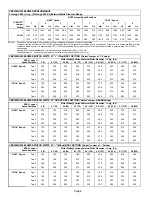
Page 12
BDC3 VARIABLE SPEED CONTROL SELECTIONS
FIGURE 5
JP1 15 PIN PLUG
(BOARD TO MOTOR)
1
2
3
4
1
2
3
4
1
2
3
4
TEST
−
+
NORM
ADJUST
HEAT
COOL
DELAY
CFM RUN
24V/1A
ACC
JP1
ACCESSORY RELAY
CONTACTS
(DRIVES OPTIONAL
ACCESSORY
RELAY)
OPERATIONAL
SELECTOR PINS
(Affects both heating
and cooling modes)
DIAGNOSTIC
DS LEDS
HEATING SPEED
SELECTOR PINS
COOLING SPEED
SELECTOR PINS
FAN DELAY
SELECTOR PINS
1
5
11
15
ADJUST"
The
ADJUST
pins allow the motor to run at normal speed,
approximately 10% higher, or approximately 10% lower than
normal speed. The blower tables give three rows (+,
NORMAL, and −) with their respective CFM volumes. Notice
that the normal adjustment setting for heat speed position #3
is 1315 CFM. The + adjustment setting for that position is
1445 CFM and for the − adjustment setting is 1185 CFM.
After the adjustment setting has been determined, chose the
remainder speed jumper settings from those offered in the
table in that row.
The TEST pin is available to bypass the BDC3 control and
run the motor at approximately 70% to test that the motor is
operational. This is beneficial primarily in troubleshooting.
G must be energized for motor to run.
COOL"
The
COOL
jumper is used to determine the CFM during
either 1) cooling or 2) heat pump operation without a call for
electric heat. These jumper selections are activated for
cooling when Y2 and DS terminals in the CBX32MV are
energized and for heating when Y2 is energized.
Applications
without
the Lennox SignatureStat
t
or
Efficiency
Plus
TM
CCB1 humidity control will provide 70% of
the
COOL
CFM during first−stage cooling for two−speed
outdoor units. Units built prior to August 2002, will provide
either 60% (−048, −060 series units) or 65% (−036 series
units) of the
COOL
CFM during first stage cooling for two
stage outdoor units. 100% of
COOL
speed is provided for
systems with a single−speed outdoor units.
NOTE − For two speed heat pump units blower will operate at
60%, 65% or 70% of
COOL
CFM.
For single speed heat pump
units blower will operate at 100%
COOL
CFM until
supplemental electric heat is demanded. At that time, the
blower will operate at
HEAT
speed selected. This arrangement
provides for warmer supply air during heat pump operation
only.
HEAT"
The
HEAT
jumper is used to determine CFM during a W1
demand for electric heat operation. These jumper
selections are activated when W1 is energized with or
without a Y1 demand for heat pump compressor.
DELAY"
The
DELAY
jumper is used to set the specific motor fan
mode of operation during cooling. Depending on the
application, one of four fan options may be chosen by
moving the jumper pins to the appropriate set of pins.
Options 1, 2, 3, or 4 will have an increased dehumidification
effect on the system. Option 1 will have the least effect and
option 4 will have the greatest effect.
Applications
with
the Efficiency
Plus
CCB1 humidity
control create different CFM volumes. For example,
during a first−stage cooling call (two−speed outdoor unit)
with no demand from the CCB1, the air volume is 40% of
the
COOL
jumper selection. For a normal
COOL
(Pin #2
setting for CBX32MV−036), the CFM is 1125; the reduced
speed is 450 CFM (1125 x 40% = 450). This arrangement
provides for additional dehumidification during standard
first stage cooling. See tables 10 and 11 for various
scenarios concerning use of the CCB1 humidity control
and the CBX32MV series unit.
Applications
with
the Lennox SignatureStat but no
demand for de−humidification will operate as follows:
during a first−stage cooling call (two−stage outdoor unit),
the air volume is 70% of the
COOL
jumper selection. For a
normal
COOL
(Pin #2 setting for CBX32MV−036), the
CFM is 1125; the reduced speed is 788 CFM (1125 x 70% =
788). This arrangement provides for additional
dehumidification during standard first stage cooling. See
tables 12 and 13 for various scenarios concerning use of
the SignatureStat and the CBX32MV series unit.
For applications with Harmony
r
zone control, the blower
CFM volume is determined by the Harmony control center.
This speed is not adjustable. See footnotes in the blower
tables (table of contents).













































